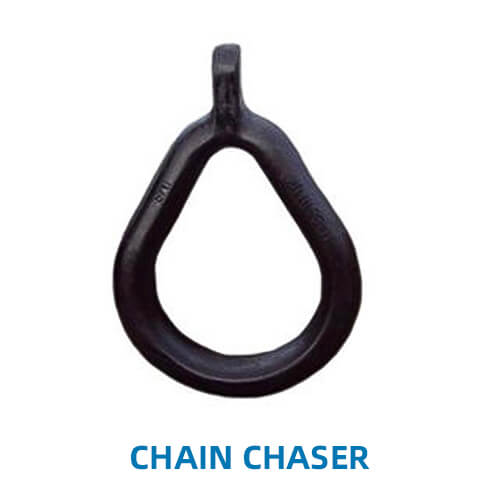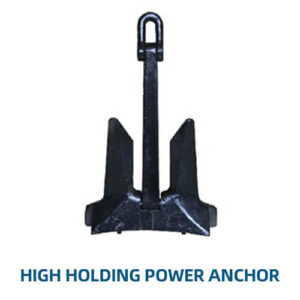Key Features of a Chain Chaser:
- Design and Construction:
- Material: Chain chasers are typically constructed from robust, marine-grade materials such as stainless steel or galvanized steel to resist corrosion and withstand heavy-duty use in harsh environments.
- Structure: The chaser usually features a sturdy frame or housing with rollers, guides, or other mechanisms designed to keep the chain aligned and moving smoothly during deployment or retrieval.
- Handle: Most chain chasers have a handle or attachment point for manual operation, though some may be integrated with winch or hydraulic systems for automated use.
- Functionality:
- Chain Guidance: The primary function of a chain chaser is to guide the chain smoothly through its path, whether it is being deployed overboard or retrieved from the sea. Proper guidance helps prevent tangling and ensures smooth operation.
- Alignment: By keeping the chain aligned, the chaser helps to reduce wear on the chain and associated equipment, such as windlasses or anchors.
- Prevention of Kinks: The chaser prevents kinks and twists in the chain, which can occur if the chain is not properly guided. Kinks can weaken the chain and disrupt its functionality.
- Types of Chain Chasers:
- Manual Chain Chasers: Operated by hand, these devices are often used in smaller vessels or in situations where automation is not required. They may include simple guide rollers or frames.
- Hydraulic or Mechanical Chain Chasers: For larger vessels or more complex operations, chain chasers may be integrated with hydraulic or mechanical systems. These systems provide automated guidance and control, improving efficiency and reducing manual labor.
- Applications:
- Anchoring: In anchoring operations, chain chasers are used to guide the anchor chain as it is deployed or retrieved, ensuring that it moves smoothly through the hawsepipe and other components.
- Mooring: During mooring operations, chain chasers help manage the chain lines used to secure vessels to docks or offshore platforms.
- Towing: Chain chasers may be employed in towing operations to handle and guide the tow chain, preventing tangles and ensuring smooth deployment and retrieval.
- Industrial Use: In industrial settings, chain chasers can be used in lifting and hoisting applications where chains are employed to handle heavy loads.
- Performance Characteristics:
- Durability: A well-designed chain chaser is built to withstand the forces and environmental conditions encountered in marine operations, including saltwater exposure and mechanical stress.
- Ease of Use: Manual chain chasers should be easy to operate and adjust, allowing crew members to quickly adapt to different chain sizes and types.
- Maintenance: Regular maintenance is essential to ensure that the chain chaser remains in good working condition. This includes checking for wear, lubrication, and alignment of the guiding mechanisms.
- Maintenance and Care:
- Regular Inspection: Inspect the chain chaser for signs of wear, corrosion, or damage. Pay attention to rollers, guides, and other moving parts to ensure they are functioning correctly.
- Cleaning: Regularly clean the chain chaser to remove salt and debris that could cause corrosion or interfere with its operation.
- Lubrication: Lubricate moving parts as needed to ensure smooth operation and prevent wear.
- Safety Considerations:
- Proper Use: Ensure that the chain chaser is used correctly according to the manufacturer’s instructions to avoid accidents and equipment damage.
- Training: Crew members should be trained in the operation and maintenance of the chain chaser to ensure safe and effective use.
- Load Limits: Adhere to the recommended load limits for the chain chaser to prevent overloading and potential failure.
Advantages of Using a Chain Chaser:
- Improved Efficiency: By guiding the chain smoothly and preventing kinks or tangles, a chain chaser enhances the efficiency of anchoring, mooring, and towing operations.
- Reduced Wear: Proper guidance and alignment reduce wear on the chain and associated equipment, extending their service life.
- Increased Safety: Preventing kinks and tangles reduces the risk of accidents and equipment failure, improving overall safety during operations.
Considerations for Chain Chasers:
- Compatibility: Ensure that the chain chaser is compatible with the size and type of chain used in your operations. Proper sizing and design are crucial for effective performance.
- Cost: While chain chasers are a valuable investment for efficient chain management, their cost should be weighed against the benefits of improved operation and reduced maintenance.
Chain chasers are important tools in marine and industrial operations, helping to manage and control chain deployment and retrieval effectively. By ensuring smooth movement and proper alignment, they enhance operational efficiency, reduce wear on equipment, and contribute to overall safety.






